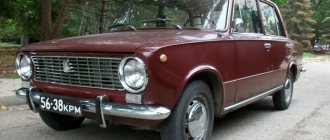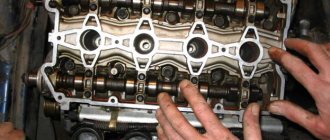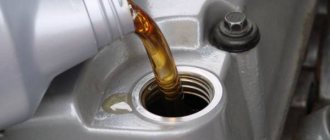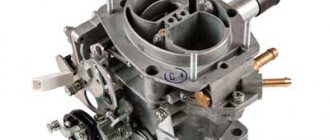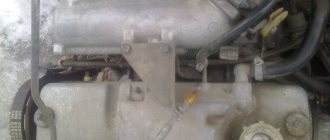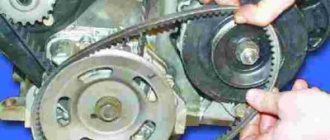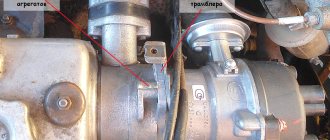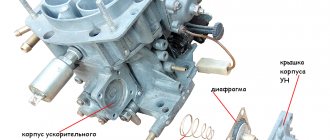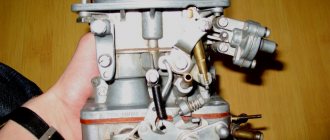VAZ-2106 engine weight
On a VAZ-2106 car, the weight of the engine without gearbox is 121 kilograms. Therefore, it is strictly not recommended to try to remove or move this unit alone - this is a direct path to serious injury. It is best to hire an assistant who can help you during the process of dismantling or installing the motor.
With all the necessary equipment, including both the cylinder head and the ignition system, the engine weight will be even greater - 140 kilograms.
Finally, when assembled with the gearbox and the devices attached to it, this value will increase by another 26 kilograms.
As you can see, weight can be considered a significant disadvantage of the car compared to imported analogues. To reduce it, increase power, and also improve dynamic characteristics, many drivers today install parts made of light metal alloys.
In 1984, a diesel version of the “six” was released at a Bulgarian automobile company. Replacing a gasoline engine with a diesel engine didn't have much of an impact on the car's performance. Firstly, the Bulgarians failed to increase the power of the power unit. Secondly, its weight increased by about 10 kilograms, which can also be called a disadvantage of the alteration.
Engine dismantling
You can reduce the weight of the power plant if you remove it without:
- Gearbox (its weight is about 30 kilograms);
- a head weighing approximately 10 kilograms.
As a rule, at service stations, power units are removed assembled with the gearbox, while during self-repair, dismantling is carried out without attachments.
Let's give an example of engine dismantling, which is described in the car's operating instructions. The peculiarity of the work in this case is that the engine is removed through the bottom of the car. The manufacturer recommends not to disconnect the box from it, but to install the car itself on a lift.
- Disconnect the terminals and then remove the battery.
- Drain the coolant and engine oil.
- Remove the crankcase protection.
- Disconnect the muffler and remove the air filter.
- Loosen the brake booster hose clamp that leads to the powertrain inlet pipe.
- Unhook the ground from the crankcase; to do this you will need to unscrew the fasteners.
- Remove the high-voltage wire from the central contact of the distributor cover.
- Using a screwdriver, turn the spring clip and remove the block with the wires coming from the contact socket of the distributor.
- Remove the fuel hose.
- Remove the clutch cable end from the clutch drive lever.
- Disconnect the wires from the traction relay, from the generator output and from the carburetor shut-off valve.
- Disconnect the air supply hoses to the throttle and the fuel hoses leading to the carburetor.
- Remove the spring from the throttle actuator.
- Remove the speedometer and accelerator drive cables from the valve covers.
- Unhook the block with the wire from the economizer, remove the oil pressure and liquid temperature sensors in the cooling system.
- Remove the heater outlet hose and transmission drive rod.
- Next, you will need to disconnect the remaining conductors from the box and move the drive shafts to the side.
- After the steering rod and other parts are disconnected, place a stand under the engine and unscrew the nuts of the rear mounting support, then the right front and left.
Before lowering the engine, check that you have disconnected everything from it. In order to remove the engine from under the car, you need to lift the front part of it.
Source: ladaautos.ru
How much does a VAZ engine weigh?
VAZ car engine weight:
| Model | Working volume, cm 3 | Power, hp | Weight, kg |
| VAZ 11183-1000260 | 1596 | 82 | 112 |
| VAZ 11194-1000260 | 1390 | 89 | 112 |
| VAZ 2103-1000260 | 1450 | 71,4 | 120,7 |
| VAZ 2104-1000260 | 1450 | 68 | 120 |
| VAZ 2106-1000260 | 1570 | 74,5 | 121 |
| VAZ 21083-1000260-53 | 1500 | 69 | 127,3 |
| VAZ 2111-100026080 | 1490 | 77 | 127,3 |
| VAZ 21114-100026080 | 1596 | 81,6 | 112 |
| VAZ 21124-100026080 | 1599 | 89,1 | 121 |
| VAZ 21126-100026080 | 1597 | 98 | 115 |
| VAZ 21128-100026080 | 1796 | 105 | 117 |
| VAZ 21213-1000260 | 1690 | 78,9 | 117 |
| VAZ 21214-1000260 | 1690 | 81 | 122 |
| VAZ 2123-1000260 | 1690 | 81 | 127 |
| VAZ 2130-1000260 | 1790 | 81,8 | 122 |
Random entries - how much does it weigh:
Permission is granted to reprint and distribute materials from this site with a direct indexed link. Thank you.
Source
How much does the VAZ weigh?
Perhaps one of the most popular cars in the post-Soviet space was, is and remains the VAZ.
This car has captivated many generations. However, how did it all begin? When was the first VAZ car produced and how much did it weigh? You will learn the answers to these and other questions from this article. The first VAZ car was produced by the Volzhsky Automobile Plant on April 19, 1970. The make of this car was VAZ-2101 Zhiguli. Its production was carried out according to the analogue of the Fiat concern. Moreover, VAZ owes its appearance to this particular brand of Fiat 124, produced in 1966. Here, in fact, is it:
As a result of some design improvements, the first domestic car, the VAZ 2101 of 1970, was produced:
The weight of this car was 955 kg. Moreover, of this mass the engine weighed 114 kg.
It has not lost its popularity to this day. In 2000, it was recognized as the best car among eighty thousand car enthusiasts surveyed in the CIS countries and Russia. It was named the best car of the century, VAZ 2101. At the time of its production, it was considered the most comfortable, reliable and modern domestic car. Its presence was a sign of wealth and prosperity!
But the Volzhsky Automobile Plant did not stop there. He created entire collections of this car. Each of them differed in its configuration, as well as its total weight. Therefore, now we will compare some VAZ models by their weight.
- VAZ 2102 has a weight of 1010 kg .
- VAZ 2103 has a weight of 965 kg .
- VAZ 2104 has a weight of 1020 kg .
- VAZ 2105 has a weight of 1060 kg .
- VAZ 2106 has a weight of 1045 kg .
- VAZ 2107 weighs 1049 kg .
- VAZ 2108 weighs 945 kg .
- VAZ 2109 weighs 915 kg .
- VAZ 2110 has a weight of 1020 kg .
- VAZ 2111 has a weight of 1055 kg .
- VAZ 2112 has a weight of 1060 kg .
- VAZ 2113 weighs 975 kg .
- VAZ 2114 weighs 985 kg .
- VAZ 2115 has a weight of 1000 kg .
- VAZ 2116 weighs 1276 kg .
- VAZ 2117 has a weight of 1110 kg .
- VAZ 2118 has a weight of 1110 kg .
- VAZ 2119 has a weight of 1110 kg .
- VAZ 2120 has a weight of 1110 kg .
- VAZ 2121 has a weight of 1550 kg .
- VAZ 2122 has a weight of 1122 kg .
- VAZ 2123 has a weight of 1300 kg .
But this is the total weight of a VAZ car. As for some parts of the car, the weight of, for example, a VAZ 2106 can be decomposed as follows:
- The weight of the engine with equipment is 140 kilograms .
- The weight of the gearbox is 26 kilograms .
- The weight of the square shaft is 10 kilograms .
- The weight of the rear axle is 52 kilograms .
- Radiator weight – 7 kilograms .
- Body weight – 280 kilograms .
Engine characteristics 2103
Years of manufacture – (1972 – present time) Cylinder block material – cast iron Power system – carburetor/injector Type – in-line Number of cylinders – 4 Valves per cylinder – 2 Piston stroke – 80 mm Cylinder diameter – 76 mm Compression ratio – 8.5 Engine displacement 2103 – 1452 cm3 Engine power 2103 – 71 hp. /5600 rpm Torque - 104 Nm / 3400 rpm Fuel - AI93 Fuel consumption - city 9.4l. | track 6.9 l. | mixed 8.9 l/100 km Oil consumption - 700 g per 1000 km Weight of the VAZ 2103 engine - 121 kg Overall dimensions of the 2103 engine (LxWxH), mm - 565x541x665 Oil for the VAZ 2103 engine: 5W-30 5W-40 10W-40 15W-40 How much engine oil 2103: 3.75 l. When replacing, fill in about 3.5 liters.
VAZ 2103 engine life: 1. According to the plant – 125 thousand km 2. In practice – up to 250 thousand km
Tuning Potential – 200 hp Without loss of resource - 80 hp.
The engine was installed on: VAZ 21023 VAZ 2103 VAZ 21043 VAZ 21053 VAZ 21061 VAZ 2107
Specifications
All engines that were installed on the VAZ 2109 were small in volume, but had sufficient power characteristics and dynamics. But things didn’t work out with the traction power. The engine power of the VAZ 2109 ranges from 54 to 81 horsepower. It is worth considering each engine option and its technical characteristics separately.
| Name | Index |
| Volume | 1.1 liter (1099 cc) |
| Number of cylinders | 4 |
| Number of valves | 8 |
| Fuel | Petrol |
| Injection system | Carburetor |
| Fuel consumption | 6,7 |
| Cylinder diameter | 76 |
| Cylinder operating order | 1-3-4-2 |
| Name | Index |
| Volume | 1.3 liters (1289 cc) |
| Number of cylinders | 4 |
| Number of valves | 8 |
| Fuel | Petrol |
| Injection system | Carburetor |
| Fuel consumption | 7.0 l |
| Cylinder diameter | 76 |
| Cylinder operating order | 1-3-4-2 |
| Name | Index |
| Volume | 1.5 liters (1499 cm3) |
| Number of cylinders | 4 |
| Number of valves | 8 |
| Fuel | Petrol |
| Injection system | Carburetor |
| Fuel consumption | 7.0 l |
| Cylinder diameter | 76 |
| Cylinder operating order | 1-3-4-2 |
| Name | Index |
| Volume | 1.5 liters (1499 cm3) |
| Number of cylinders | 4 |
| Number of valves | 8 |
| Fuel | Petrol |
| Injection system | Injector |
| Fuel consumption | 7.5 l |
| Cylinder diameter | 82 |
| Cylinder operating order | 1-3-4-2 |
| Name | Index |
| Volume | 1.6 liters (1596 cc) |
| Number of cylinders | 4 |
| Number of valves | 8 |
| Fuel | Petrol |
| Injection system | Injector |
| Fuel consumption | 9.5 l |
| Cylinder diameter | 82 |
| Cylinder operating order | 1-3-4-2 |
As you can see, the evolution of engines has come from the carburetor type to the injection type. Although with an increase in engine volume, fuel consumption also increased proportionally.
Description
The VAZ 2103 engine is manufactured using a “high” cylinder block (215.9 mm instead of 207.1 mm), which made it possible to increase its working volume to 1.5 liters and install a crankshaft with an increased piston stroke.
The unit is a classic version of an engine with an overhead gas distribution mechanism.
The camshaft is driven by a chain drive, and there is no chain tensioner. Therefore, chain tension must be checked and adjusted regularly. In addition, the valve clearances also need to be adjusted, since the gas distribution mechanism does not have hydraulic compensators.
The cylinder block is made of cast iron, and its head is cast from an aluminum alloy. The camshaft is made of steel and differs from other models by the presence of one untreated neck, which is shaped like a hexagon. The carburetor, which is installed on the VAZ 2103 engine, is equipped with a distributor with a vacuum ignition timing regulator. After the advent of injection power units, a modified cylinder head with a corresponding gas distribution mechanism began to be installed on the engine. To operate the water pump (pump), a drive with a V-belt with a cross-section of 10x8 mm is used. Oil is supplied from the crankcase to the internal channels of the cylinder block and to friction pairs carried out using an oil pump located in the crankcase of the power unit. Both classic and non-contact ignition systems were installed on the 2103 engine.
The most common defects of the VAZ 2103 and their causes
Like all internal combustion engines, the 2103 engine may have malfunctions, especially the following breakdowns:
- The engine does not start.
- The engine stalls at idle speed or there are floating speeds.
- Increased consumption of motor lubricant.
If the VAZ engine cannot be started, this may be caused by the following reasons:
- fuel does not enter the carburetor;
- the fuel filter is excessively dirty;
- fuel pump failure;
- The carburetor solenoid valve does not work.
For the symptoms described in the second paragraph, the reasons are as follows:
- violations in idle speed adjustments;
- carburetor failure;
- The gaps between the cams and camshaft levers are not adjusted.
If oil consumption is increased, the following reasons are observed:
- oil leaks through worn seals;
- Excessive wear on piston rings or cylinder walls;
- Oil reflecting valve caps are damaged or worn.
aleks-7707 › Blog › VAZ-2106 engine (block assembly, unit, engine assembly) NEW
For VAZ 2101-2107, VAZ-2121 “NIVA”
The cost of the engine depends on the configuration: Complete unit RUB 23,000. Unit 34,000 rub. Engine assembly 42,000 rub.
Engine (2106-1000260) manufactured by JSC AVTOVAZ with all warranty obligations NEW. All primary documents are available!
Motor 2106 has been used and can be used on VAZ 2103, 2106, 2121, 21053, 2107 cars.
For components, assemblies, engines and gearboxes, the warranty is 15 thousand km or 1 year, whichever comes first. The warranty period is 1 year or 15 thousand kilometers due to the inability to control the operating conditions of the listed products, the replacement interval and the quality of fuels and lubricants.
You can also make any set of attachments (standard and non-standard) if you have some of the equipment - write what to add/exclude from the set, the manager will write a price change...
The engine is four-stroke, carburetor, in-line, with an overhead camshaft. The engine cooling system is liquid, closed type, with forced circulation of liquid. The engine has a combined lubrication system: pressure and splash.
Minus (“weight”) of electrical equipment of VAZ 2108, 2109, 21099 cars
As you know, on VAZ 2108, 2109, 21099 cars the electrical equipment is made according to a single-wire circuit. The function of the negative (“mass”) wire is performed by the car body and engine. Therefore, the negative terminals of all electrical appliances (electricity sources and consumers) are connected to the body or engine.
Features of fastening the “ground” of electrical equipment of VAZ 2108, 2109, 21099 cars
— Connection “negative battery terminal – engine and car body”
The negative thick wire (usually black) goes from the negative terminal of the battery to the gearbox housing (see photo above). Another thick wire (most often the so-called “braided wire”) from the same negative terminal goes to the body and is attached to a stud next to the battery. This connection ensures the presence of a “minus” from the battery terminal on all electrical devices after turning the key in the ignition and ensures normal operation of the starter (stable engine starting).
— Connection “generator – engine”
This is ensured by the location of the generator directly on the engine, which is constructive for VAZ 2108, 2109, 21099. After starting the engine and turning on the generator, the “minus” and “plus” of the car’s electrical equipment will now be tied to it, and not to the battery.
Malfunctions of the “mass” of electrical equipment of cars
There are usually only two ground faults.
— Poor (oxidized) contact at the connection points
— “Break” in the wires
If there is poor contact with ground, problems with starting the engine are possible (the retractor relay clicks, the starter does not turn). In such a situation, many begin to repair or change the starter, although it is only necessary to clean the contact points of the ground wire to the engine (box) and the body or the negative terminal with the output to the battery.
In addition, reliable ground contact is important for the normal operation of electrical consumers on a car (headlights, heater, wipers, etc.). For example, so-called “wandering” malfunctions or “glitches” often occur, when the device sometimes works, sometimes doesn’t, and then works again. In such a situation, it is necessary, first of all, to put in order the main “mass” wires coming from the battery terminal, and secondly, to check the reliability of the connection of the “negative” wire going from each device to the minus (usually the black wire).
Fastening to the body - the “ground” of the front headlight of VAZ 2108, 2109, 21099 cars and their modifications
A “break” in the wires can occur when the “mass” wire is broken or is severely oxidized at the point of attachment to the “negative” terminal of the battery.
“Weight” of the rear light of VAZ 2108, 2109, 21099 cars
Notes and additions
— In addition to checking the “negative” connections of the electrical equipment of VAZ 2108, 2109, 21099 cars, in case of problems with starting the engine or operating electrical appliances, it is also necessary to measure the voltage at the terminals of the battery in order to assess the degree of its performance. Its malfunction or low charge level can cause the ground-related malfunctions described above.
Twokarburators VK - More information on the topic in our VKontakte group, on Facebook Twokarburators FS and on Odnoklassniki - Twokarburators OK
More articles on electrical equipment of VAZ 2108, 2109, 21099 cars
— Features of removal and installation of the battery on VAZ 2108, 2109, 21099 vehicles
— Short circuit in the car’s electrical wiring, how to look for it
— Checking the generator of VAZ 2108, 2109, 21099 cars (without removing from the engine)
— Headlights are dim, causes of malfunction
Other characteristics of the VAZ-2106 engine
The weight of the motor is, although important, but far from its main characteristic. That is why we decided to talk about other features of the power unit installed on various modifications of the “six”. For example, engine power on carburetor models was 77 horsepower. After switching to an injector, it dropped to 75 hp. With. However, this parameter can always be increased by carrying out a number of upgrades.
The cylinder diameter of the VAZ-2106 power unit is 79 millimeters, the torque can reach 3000 rpm, and the working volume is 1568 cubic centimeters. Finally, the compression ratio of the engine is 8.5 atmospheres, and the piston stroke is 80 millimeters.
Engine weight and other characteristics
The lightest is the latest engine model 11183-20 - it weighs 112 kilograms. The remaining modifications are heavier (almost 128 kilograms). Interestingly, the lightest modification in weight is the most powerful - it has 81 horsepower. The first power plants were much more modest in parameters - the 2108 had only 64 hp. s., and 21083 has 69 “horses”.
What the power units have in common is the number of cylinders - all are equipped with four. Moreover, the first modification has a cylinder diameter of 76 millimeters, and subsequent modifications have a cylinder diameter of 82 mm. By volume, the engines have the following parameters:
- 2108 – 1.3 liters;
- 21083 – 1,5;
- 2111 – 1,6.
Engine 21081 was similar in basic parameters to the base one, but had low power - only 54 horsepower. An intermediate option, before the start of production of cars with a power plant from Kalina, was the injection 2111-80. The number of “horses” in it increased to 72, and the maximum speed reached 160 km/h.
What power units were used on the VAZ-2109
This car’s own engine model, marked “2109,” never existed; power units were installed instead:
Initially, the VAZ-2109 received units 21081 and 2108, which were installed on it from 1987 to 1997. They were based on a carburetor that supplied fuel. These power plants were replaced due to a malfunction that was unpleasant for many car enthusiasts - when the timing belt broke, the valve covers were bent.
Model 21083 was also equipped with a carburetor; “nines” are most often found with it. This engine model was developed back in 1987, and began to be installed only in the nineties.
This version of the engine is a modified 2108. The main difference of the power unit is that if the timing belt breaks, the valve pistons do not bend.
Injection engine modifications were initially intended only for export. They were developed on the basis of the 21083 engine. The first version was 2111-80, which subsequently underwent a deep modernization in order to increase its power. The converted version was released under the marking 11183-20. Since 1998, cars with these engines began to be sold on the domestic market.
How much does a VAZ 2109 engine weigh - Auto repair school
One of the most famous developments of Soviet motor vehicles is the VAZ 2109 engine and its various modifications. Thus, the motor, which was developed back in 1982, serves faithfully to this day. This is one of the most common engines in the CIS.
It must be said that this is not considered one of the reliable units, but it is very repairable, which makes it quite popular among car enthusiasts.
Description and modifications
As such, a “nine” engine does not exist in nature. At least, the AvtoVAZ plant did not produce it. All 2109 models were equipped with a figure-eight power unit and its modifications. Of course, in many documents you can find the VAZ 2109 engine, but this is deception or ignorance.
But in the technical documentation of the manufacturer you cannot find information about the 2109 engine, since such an engine does not exist. Over the entire period of their production, all “nines” were equipped with engines with the following markings: VAZ-21081 (1.1 8V), VAZ-2108 (1.3 8V), VAZ-21083 (1.5 8V), VAZ- 2111-80 (1.5i 8V) and VAZ-11183-20 (1.6i 8V).
Specifications
All engines that were installed on the VAZ 2109 were small in volume, but had sufficient power characteristics and dynamics. But things didn’t work out with the traction power. The engine power of the VAZ 2109 ranges from 54 to 81 horsepower. It is worth considering each engine option and its technical characteristics separately.
| Name | Index |
| Volume | 1.1 liter (1099 cc) |
| Number of cylinders | 4 |
| Number of valves | 8 |
| Fuel | Petrol |
| Injection system | Carburetor |
| Fuel consumption | 6,7 |
| Cylinder diameter | 76 |
| Cylinder operating order | 1-3-4-2 |
| Name | Index |
| Volume | 1.3 liters (1289 cc) |
| Number of cylinders | 4 |
| Number of valves | 8 |
| Fuel | Petrol |
| Injection system | Carburetor |
| Fuel consumption | 7.0 l |
| Cylinder diameter | 76 |
| Cylinder operating order | 1-3-4-2 |
| Name | Index |
| Volume |
Source: https://oooyuma.ru/obsluzhivanie/skolko-vesit-dvigatel-vaz-2109.html
Characteristics of VAZ 2103
VAZ 2103 is a four-door classic sedan from the Volzhsky Automobile Plant. In 1972, AvtoVAZ launched a more powerful version of the Zhiguli, the VAZ-2103, which was perceived by many as a completely new, more powerful and comfortable model. Naturally, for the vast majority of the population it is much more prestigious and expensive. In fact, it was only a “Lux” modification, fully consistent with the 1968 FIAT 124 Speciale, the design of which was redesigned in the same way as the base FIAT 124 turned into the VAZ-2101. The development of its production was provided for by an agreement with the FIAT concern somewhat later than the base models, and it was equipped with a 1.5-liter engine model 2103 with a power of 77 hp.
In 1972, production of the VAZ 21035 model also began, which is completely identical in appearance to the VAZ 2103, but with a VAZ 2101 engine. The start of production of the VAZ 21033, which is completely identical in appearance to the VAZ 2103, but with a VAZ 21011 engine, took place in 1977.
Before the appearance of the more prestigious VAZ-2106 on the market and for some time after that, the “2103” was in great demand and was deservedly considered the most comfortable and dynamic. Its popularity in the late 1970s was even greater than the recently appeared “Six” and “Niva”, which were considered unjustifiably “complicated”, expensive and generally foppish. Nowadays, the ratings of these cars have fallen dramatically: for example, the VAZ-2103 has hardly been stolen in recent years. This is understandable, since the last VAZ “three rubles” stopped being collected a decade and a half ago!
Although the differences in the interior trim of the “treshka” from the “kopek” are quite significant, nevertheless, the back row of seats of this sedan has not become more spacious, but the headroom in comparison with the VAZ-2101 has increased by 15 mm (due to a different seat design), and The distance from the ceiling to the seat is 860 mm. The instrument panel, in which the clock and tachometer are installed, is completely different - “rich”. The seats and upholstery are different from the VAZ-2101, which was cool for the 1970s, but the subsequent “six” really looked more advantageous in this regard. Like all classic sedans, the Zhiguli VAZ-2103 model has the same disadvantages, such as: inconvenience of loading luggage due to the high rear panel, a small “glove compartment” without lighting, weak light in the cabin, etc. From the point of view of modern ergonomics, the differences from the “penny” seem ridiculous. Until 1980, the windshield washer pump was a foot-operated type.
Leatherette seats with low backs were not even equipped with headrests, and the interior was never actually modernized, and by the end of production (1984) it was significantly outdated, or rather became “unfashionable.” Although it must be admitted that the build quality in those days was higher: for example, the size of the gaps in the body panels and the fit of the doors did not cause any complaints. The basic 77-horsepower VAZ-2103 engine allowed this sedan to reach a speed of 100 km/h in 19 seconds. For export modifications of the VAZ-21033 and VAZ-21035, 1.3-liter VAZ-21011 engines with a power of 69 hp were respectively installed. or the completely undynamic, but “economical” 64-horsepower VAZ-2101 engine, the noise from which and from the oncoming air flow was simply shocking. In the last decade, a number of such low-power modifications have been re-exported back to Russia.
Having maintained the ground clearance of 170 mm under the rear axle housing, the car, due to the lower “settlement” of the body than that of the Moskvich, on an uneven dirt road catches all the bumps and “ridges” with the exhaust pipe manifold. At the same time, the behavior on the road is typical for a “classic”: the car does not behave quite correctly - the “soft” suspension and, as a result, the blurred feedback of the “steering wheel” make it difficult to control at full speed on a slippery road. Electrical changes due to changing technology occurred in 1977, when new terminals and wiring connections began to be installed. The carburetor has undergone several modernizations. The first was in 1974, when its design was only slightly revised, and in 1976 a quality screw was added. In 1980, they began installing an Ozone carburetor model 2107.
It is quite difficult to find original spare parts for the “three ruble” (especially chrome radiator lining and bumpers with chrome “fangs”), but nevertheless, due to the high degree of unification and due to the fact that car service mechanics know the design well, the car can be re-equipped without any problems interchangeable components and assemblies from the most common model - VAZ-2106.
Service
This section includes changing the oil and adjusting the valves (8 and 16 valve engines).
Experts recommend changing the oil every 15 thousand kilometers. If you do not comply with these requirements, the power unit will quickly fail. The fact is that oil loses its properties over time and accumulates many harmful substances. Without changing the oil and flushing the engine, the car will not last long. The VAZ 2110 engine mounts are also being replaced.
Procedure during draining:
- Unscrew the plug located under the bottom of the power unit. In this case, you can use a special key;
- Carefully drain the used oil so that it does not get on your skin. If you are not careful, you can get a very serious burn to the skin as the oil is very hot;
- Next, you can wipe the bottom of the power unit to get rid of any remaining oil;
- Screw the plug back;
- We unscrew the oil filter, which is located under the hood of the vehicle. To make your work easier, you can use a set of keys. We also replace the engine mount;
- Coat all filter gaskets with a thin layer of oil. This is necessary so that the filter can easily fit into the fitting place. The force applied should be monitored very carefully. If you exaggerate with force, you will strip the thread.
Actions during pouring:
- Carefully unscrew the filler cap;
- We take new oil in our hands and begin to pour it into the neck in the amount of three liters. In this case, you need to monitor the level so as not to overfill. Otherwise, the oil will end up in unnecessary areas of the engine;
- Next, you can start the power unit and wait a few minutes until the system warms up and the oil goes through several circles. Only after 20 minutes can you check the oil level. If it is not enough, then feel free to add more. In other cases, the process is completed, you can screw on the cover and put in the replaced engine mount;
- We also check the dashboard. The Check Engine light should not be on.
This process is the most complex and quite interesting. The performance of the power unit and its stability will depend on the correctness of the actions.
If you want to tune the VAZ 2110 engine, then adjusting the valves can be classified as some kind of tuning.
The adjustment is carried out using the device:
- Open the valve mechanism cover and completely remove the timing belt cover;
- We install a device that will allow you to easily carry out all the actions;
- We put the necessary marks on both the crankshaft and the camshaft. They are necessary for proper adjustment. You should also check the timing belt. It should be taut, not hanging;
- Checking the gap;
- Next, unscrew the washer and replace it with a new one according to the formula:
- where A is the measured gap;
- B – thickness of the removed washer;
- C – nominal gap;
- N – thickness of the new washer.
Other engine modifications: intake and exhaust
If you take into account the recommendations of experts, in order for the engine to turn out to be resourceful, you should not strive to increase its volume beyond the 1.6 liter mark. An increase in volume above this figure will mean that the engine becomes “heavier” and spins less intensively.
As for improvements, special attention should be paid not only to the block, but also. The modification involves grinding the cylinder head channels through which fuel flows from the intake manifold. It is important to achieve not only a larger channel cross-section, but also a smooth transition, and also that all channels end up being the same.
The next step will be to modernize the exhaust channels and. The channels are polished and the valves can even be replaced. For example, a suitable option is selected (it can also be from a foreign car), after which the valve stems are processed to the dimensions for a VAZ engine.
The valve plates should also be processed at the same time. It is important to adjust all valves according to weight. Separately, it is worth approaching the issue of installation. In order for the engine to pull well from the bottom and at high speeds, it is optimal to select a camshaft that provides high valve lift. At the same time, a split gear is also required for precise adjustment.
Disadvantages and advantages
The main advantage is that the 21083 engine does not bend the valve when the timing belt breaks. In addition, the engine incorporates design solutions that provide a number of advantages:
- no oil starvation at startup - a special coating is used to preserve oil on the surface of the pistons;
- free rotation of the pin in the connecting rod bosses - overhauls are performed less frequently;
- massive upper connecting rod head – the life of the crankshaft increases, major repairs are cheaper;
- modification of the pump - the cooling system lasts longer.
Piston group kit
Despite the fact that the cylinders have a maximum diameter, it is possible to tune the internal combustion engine with your own hands in other ways. The disadvantages are:
- it is impossible to install pulleys of additional attachments on the internal combustion engine shaft;
- torque at high speeds is low;
- high thermal loads are dangerous due to the pressing of the head plane, crushing of the bosses and cracks in the exhaust manifold.
VAZ 2109 engine weight
Unlike its fellow “eight” VAZ-2109 “Sputnik” (Lada Samara), the “nine” is considered as a more “respectable” car for a family man - due to the presence of five doors and, as a result, a less expressive appearance. However, this five-seater hatchback (especially in the first years of production) did not escape the fate of being called a “chisel” for its characteristic wedge-shaped body contours.
How much does the VAZ 2109 weigh?
Small class passenger cars with front-wheel drive and a transverse engine. Produced by the Volzhsky Automobile Plant since 1988. The body of the VAZ-2109 and VAZ-21093 is a monocoque, five-door, two-volume hatchback.
The front seats have headrests and are adjustable in length and backrest angle. The rear seat can be folded down to increase luggage space.
Cars can be equipped with an electrically heated rear window, wipers and washers for the rear window and headlights.
Currently the model is called “Lada Samara”
Characteristics of ICE 2108
German designers built a small amount of power into the engine, sufficient for a three-door hatchback weighing less than 1 ton. The timing drive again became a belt drive, but the shortcomings of the previous generation 2105 were taken into account. The existing cooling system was ideal for a small engine; replacing it was not practical in terms of cost.
Timing belt drive
ICE 2108 has advanced technical characteristics for its time:
| Manufacturer | VAZ |
| Engine brand | VAZ-2108 |
| Years of production | 1984 – 2004 |
| Volume | 1.3 l |
| Power | 47.2 kW (64 hp) |
| Torque | 95 Nm (3400 rpm) |
| Weight | 127 kg |
| Compression ratio | 9,9 |
| Nutrition | carburetor Solex 1107010 two-chamber emulsion mechanical (cable drive) |
| Motor type | in-line |
| Number of cylinders | 4 |
| Location of the first cylinder | near the timing chain |
| Number of valves on each cylinder | 2 |
| Cylinder head material | aluminum alloy |
| Allowable warpage | manifold gaskets (intake/exhaust) 0.08 mm, cylinder head gasket 0.05 mm |
| Valve seat | width 2 mm, angle 45° |
| Camshaft | one upper cylinder head inside, phase width 232°, exhaust valve advance 42°, intake valve lag 40° |
| Camshaft oil seal | diameters – 40 mm, 56 mm, width 7 mm |
| Cylinder block material | cast iron |
| Cylinder diameter | class A – 76 – 76.01 mm class B – 76.01 – 76.02 mm class C – 76.02 – 76.03 mm class D – 76.03 – 76.04 mm class E – 76.04 – 76.05 mm |
| Pistons and rings | piston made of aluminum alloy, cast iron rings, compression rings - chrome plated on the outside (top) and beveled (bottom) |
| Piston diameter | class A – 75.94 – 75.95 mm class C – 75.96 – 75.97 mm class E – 75.98 – 75.99 mm |
| Gaps | piston/cylinder wall – 0.153 – 0.173 mm (standard) or 0.19 mm (maximum) piston rings – 110 mm relative to the cut plane |
| Upper compression ring | 1.535 – 1.555 mm |
| Lower compression ring | 3.957 – 3.977 mm |
| Oil scraper ring | 2.015 – 2.035 mm |
| Gap between piston groove and ring | 0.04 – 0.07 mm (compression lower) 0.02 – 0.055 mm (oil scraper) 0.03 – 0.06 mm (compression upper) |
| Crankshaft | cast iron, casting |
| Number of main bearings | 5 |
| Gearbox neck diameter | 50.799 – 50.019 mm |
| Main journal gap | 0.1 – 0.5 mm |
| Connecting rod bearings | shaft journal diameter – 47.83 mm liner thickness – 1.448 mm liner width – 28.025 – 28.975 mm |
| Crankshaft oil seals | front – diameters 42 mm, 60 mm, width 7 mm rear – diameters 85 mm, 105 mm, width 10 mm |
| Piston stroke | 71 mm |
| Fuel | AI-92 (A-76 allowed) |
| Environmental standards | Euro 2 |
| Fuel consumption | highway – 7 l/100 km combined cycle 8.2 l/100 km city – 10 l/100 km |
| Oil consumption | maximum 0.7 l/1000 km |
| Engine oil for 2108 | 5W-30 and 15W-40 |
| Engine oil volume | 3.5 l |
| Replacement frequency | every 15,000 km |
| Working temperature | 80° |
| Motor life | declared 120,000 km actual 200,000 km |
| Adjustment of valves | washers |
| Cooling system | forced, antifreeze-A40M, Spectrol |
| Coolant quantity | 7.3 l |
| water pump | polymer impeller, mounted on a block |
| Ignition | non-contact, switch, coil, commutator and distribution sensor |
| Candles for 2108 | Thread M14x1.25 mm, thread length 19 mm, glow number 17 |
| Gap between spark plug electrodes | 0.7 – 0.8 mm |
| Timing belt | 111 teeth |
| Cylinder operating order | 1-3-4-2 |
| Air filter | dry with replaceable cardboard cartridge and pre-cleaner, temperature adjustment according to the season |
| Oil filter | recommended Mann W914/2 |
| Flywheel | 129 teeth, 0.62 kg internal hole diameter – 25.67 mm outer diameter – 27.75 mm number of mounting holes – 6 pieces |
| Flywheel mounting bolts | M10x1.25 mm, length 23.5 mm |
| Valve stem seals | Manufacturers Horse or Corteco |
| Compression | pressure in the cylinders from 11 – 14 bar, pressure difference in individual cylinders within 1 bar |
| Oil temperature | 80°С |
| Thermostat temperature | 80 – 84°С |
| Valve pressure inside the radiator cap | 0.7 – 1 bar |
| Content of harmful products in the exhaust | CH |
| XX speed | 600 – 700 min-1 |
| Tightening force of threaded connections | spark plug – 31 – 39 Nm flywheel – 62 – 87 Nm clutch bolt – 19 – 31 Nm bearing cap – 69 – 84 Nm (main) and 44 – 54 Nm (connecting rod) cylinder head – 4 stages 20 Nm, 71 Nm + 90° + 90° The manufacturer recommends using exclusively the given parameters for clearances and tightening forces of threaded connections. It is indicated which oil to pour into the engine and lubrication system.
Source Adblock detector |
VAZ. Which engine is better???VAZ 2106 or 2103?
just a little boost
yeah, right now, the same. The volumes are different, some 2106 have 1.5
so they look the same...
The troechny has always been the best engine on VAZ..
Calla and both - they were invented in Italy in 1969, for VAZ, and in Tolyatti they are still installed on new cars - cunt. ts!!!!
2106 is 1.6l, 2103 is 1.45l. 2106 is a little more powerful.
1500 and 1600 volume—All the difference
2106 which, with a volume of 1600, is the most durable of the Zhiguli ones
depending on the engine modification
The most reliable engine is 1300 cc for classics, followed by 1600 and the last 1500. I have arguments and gained experience in the 80-90 years of repairing hundreds of these engines.
basin-shaped, all the same
definitely 2103!!! I drove this one myself for 195,000 km. There were no problems and no repairs either. Timely adjustment of valves, tightening of the chain, Castrol oil 10 Dabolyu 60 replacement every 10,000 km.
C grade - the most repairable! By the way, the 21063 was equipped with a 21011 engine - 1300cc.
touch.otvet.mail.ru
Engine characteristics VAZ 2112 1.5 16V
| Parameter | Meaning |
| Configuration | L |
| Number of cylinders | 4 |
| Volume, l | 1,488 |
| Cylinder diameter, mm | 82 |
| Piston stroke, mm | 71 |
| Compression ratio | 10,5 |
| Number of valves per cylinder | 4 (2-inlet; 2-outlet) |
| Gas distribution mechanism | DOHC |
| Cylinder operating order | 1-3-4-2 |
| Rated engine power / at engine speed | 68.4 kW-(93 hp) / 5600 rpm |
| Maximum torque/at engine speed | 133.3 N•m / 3300 rpm |
| Supply system | distributed injection with electronic control |
| Recommended minimum octane number of gasoline | 95 |
| Environmental standards | Euro 3 |
| Weight, kg | 120 |
VAZ-2109
Small class passenger cars with front-wheel drive and a transverse engine.
Produced by the Volzhsky Automobile Plant since 1988. The body of the VAZ-2109 and VAZ-21093 is a monocoque, five-door, two-volume hatchback. The front seats have headrests and are adjustable in length and backrest angle. The rear seat can be folded down to increase luggage space. Cars can be equipped with an electrically heated rear window, wipers and washers for the rear window and headlights. Currently the model is called "Lada Samara"
Car modifications:
Engine.
Maud. VAZ-2108 (for the VAZ-2109 car), petrol, in-line, 4-cylinder, 76×71 mm, 1.3 l, compression ratio 9.9, operating order 1-3-4-2. power 47 kW (63.7 hp) at 5600 rpm, torque 94 N-m (9.6 kgf-m) at 3400 rpm. Carburetor 2108-11070-10-78. Air filter - with automatic thermostat and replaceable filter element. Engine cooling system - with an electric fan that automatically turns on and off,
Mod.VAZ-21083 (for VAZ-21093, -21099 cars and their modifications), petrol, in-line, 4-cylinder. 82x71 mm, 1.5 l, compression ratio 9.9, operating order 1-3-4-2. power 51.5 kW (70 hp) at 5600 rpm, torque 106.4 N-m (10.85 kgf-m) at 3400 rpm.
Transmission.
The clutch is single-plate, with a diaphragm spring. The clutch release drive is cable. Gearbox: 5-speed, with synchronizers in forward gears. Before. Numbers: I-3.636; II-1.96; III-1.357, IV-0.941, V-0.784. ZX-3.53. The main gear is cylindrical, helical, gear ratio is 3.94. Differential - conical, two-satellite. The front wheels are driven by shafts with constant velocity joints.
